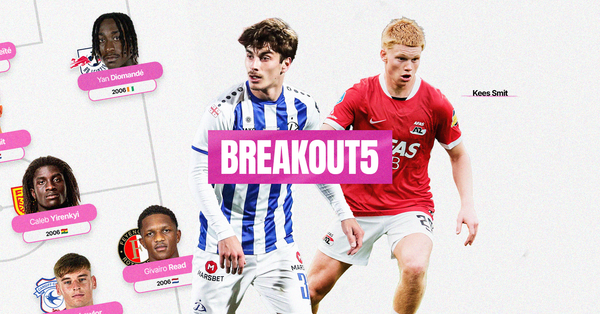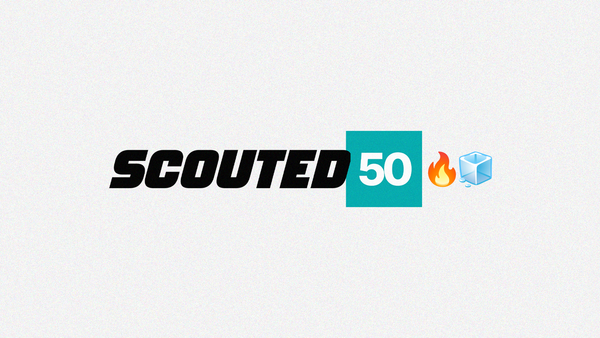Superpowers, discovered: translating the eye test into data
The source of Woltemade's success, Mosquera’s Archetype analysed, and more findings from the 2025 UEFA U-21 EURO
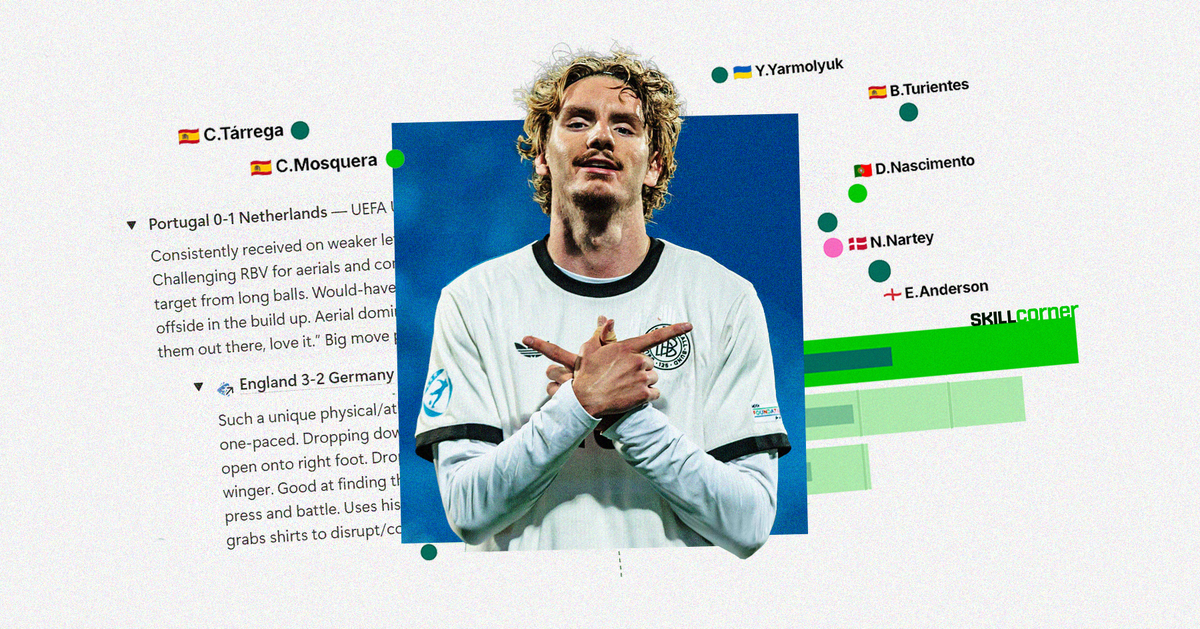
A good relationship between traditional scouting and data scouting is symbiotic.
Clear alignment between the eye-test and data is often seen as the hallmark of a well-run recruitment department. At SCOUTED, our Archetypes are kindled by the things we see on the pitch. Then, we interrogate data to try to capture that style and substance on a spreadsheet. We use that data to discover more players to watch, which helps unearth more valuable traits, which creates more robust Archetypes. And so on.
This summer, SkillCorner provided us access to Game Intelligence data for the UEFA Under-21 European Championship. We watched every game, built a database of match reports, and selected a Team of the Tournament. Then, I used SkillCorner’s data to interrogate our eye-tests to see what unearthed.
This journey led me to a key discovery in the ongoing attempt to understand Nick Woltemade, important insights into Arsenal target Christhian Mosquera’s style, and a few other fascinating bits to help us refine our player discovery at the next youth tournament.
Here are five players we loved from the U-21 EUROs, and five discoveries the cross-referencing of match notes and data helped us make.

Centre-back: Cristhian Mosquera
We’ll begin at centre-back, with Cristhian Mosquera. Our notes on him from Spain’s 1-3 defeat to England interested me, and I wanted to explore them first:
That sounds exactly like the Super Sweeper Archetype - a Sentinel - which is all about engaging the thrusters to mop up danger. Let’s see if I’m right.
In SkillCorner terms, we should expect to see a large number of Sprints, a high Percentage of High Intensity Activity as Sprints, plenty of Explosive Accelerations to Sprint and a high Percentage of Sprints reached via Explosive Accelerations. For comparison and contrast, I will highlight both Charlie Cresswell and Chico Lamba in all the data visualisations we use, as they were our Team of the Tournament’s centre-backs. The latter has recently signed for Saint Étienne.
Physical Metrics Glossary
- TIP: When the team has the possession
- OTIP: When the opponent team has the possession
- Total Distance: Total distance covered.
- M/min: Total distance covered divided per number of minutes. For TIP (resp OTIP), it's divided per number of minutes TIP (resp OTIP).
- Running Distance: Distance covered between 15km/h and 20km/h.
- High Speed Running (HSR) Distance: Distance covered between 20 and 25 km/h.
- Sprinting Distance: Distance covered above 25 km/h.
- High Intensity (HI) Distance: Distance covered above 20 km/h.
- Count HSR: Discrete activity with a speed moving average over one-second window between 20 and 25 km/h.
- Count Sprint: Discrete activity with a speed moving average over one-second window higher than 25 km/h.
- Count HI: Sum of Count HSR and Count Sprint.
- Count Medium Acceleration: Discrete activity between 1.5 m/s² and 3 m/s². The activity needs to last for at least 0.7s.
- Count High Acceleration: Discrete activity exceeding 3 m/s². The activity needs to last for at least 0.7s.
- Count Medium Deceleration: Discrete activity between -1.5 m/s² and -3 m/s². The activity needs to last for at least 0.7s.
- Count High Deceleration: Discrete activity under -3 m/s². The activity needs to last for at least 0.7s.
- PSV-99: Peak sprint velocity 99th percentile. This metric reflects the peak speed of a player and its ability to reach it multiple times or sustain it long enough.
- TOP 5 PSV-99: When averaged by player only. Best 5 PSV-99 performances by player.
- Count Explosive Acceleration to HSR: Count of High Accelerations (see definition above) starting from a speed below 9km/h and reaching at least 20 km/h.
- Count Explosive Acceleration to Sprint: Count of High Accelerations (see definition above) starting from a speed below 9km/h and reaching at least 25 km/h.
- Time to HSR: The minimum time spent between 9 km/h and 20 km/h when achieving an Explosive Acceleration to HSR during a performance.
- TOP 3 Time to HSR: When averaging performances, provides the average of the 3 best Time to HSR performances. Note that this metric is provided only if the player has 3 performances with a Time to HSR.
- Time to Sprint: The minimum time spent between 9 km/h and 25 km/h when achieving an Explosive Acceleration to Sprint during a performance.
- TOP 3 Time to Sprint: When averaging performances, provides the average of the 3 best Time to Sprint performances. Note that this metric is provided only if the player has 3 performances with a Time to Sprint.
The data suggests Mosquera’s leggy and lean build lends itself to High Speed Running (20 km/h to 25 km/h) as opposed to Sprinting (>25 km/h), at least in this tournament. He ranks above average for PSV-99 and Sprints P30 OTIP - but he is not an outlier like French centre-back Chrislain Matsima or Germany's Max Rosenfelder - the latter missed the final due to a hamstring injury, go figure.
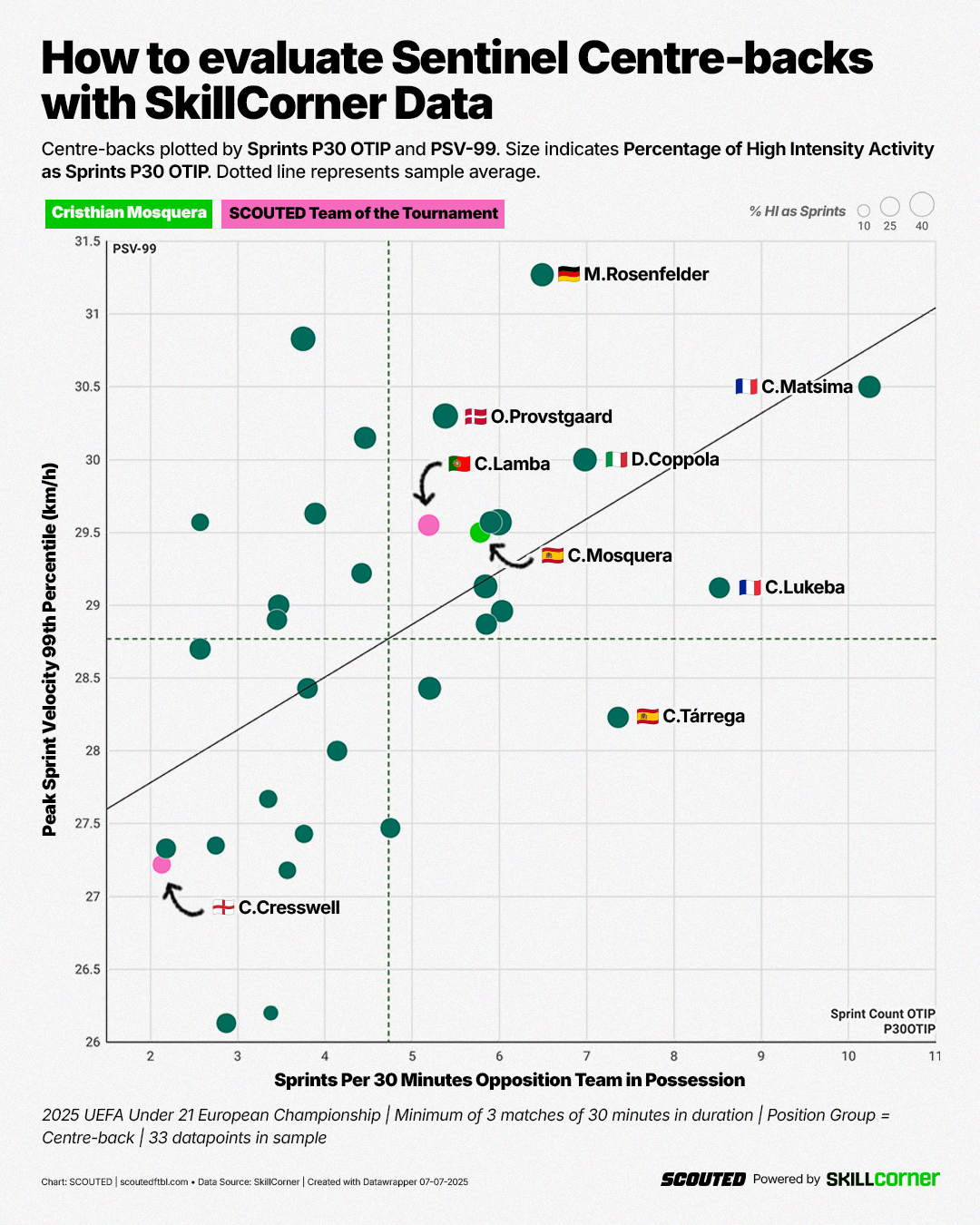
In the High Speed Running band, not only does he rank fourth for HSR P30 OTIP, he also ranks fourth for Percentage of Running Distance P30 OTIP as HSR Distance.
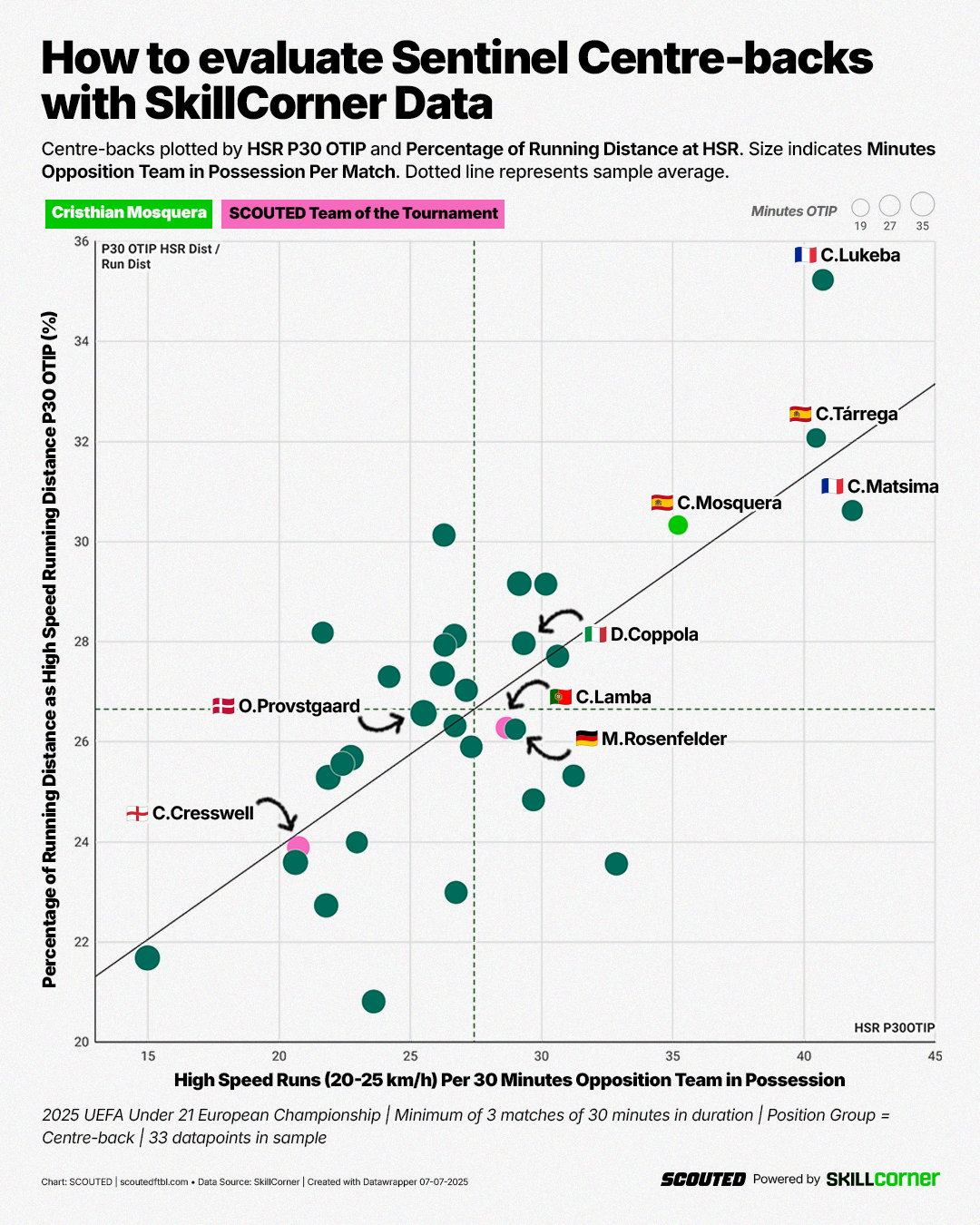
Interestingly, the top four in both metrics play for either Spain or France. Team environment is an important context to consider. Mosquera and Tárrega averaged the fewest Minutes OTIP Per Match; adjusting the size of each datapoint based on that metric helps keep some perspective.
Meanwhile, Accelerations in general appear to be a Spanish superpower. Mosquera and his partner César Tárrega are the only two centre-backs that rank in the top four for the following metrics P30 OTIP:
- Medium Accelerations
- High Accelerations
- Explosive Accelerations to HSR
- Explosive Accelerations to Sprint
Mosquera ranks first for High Accelerations P30 OTIP and second when combining Explosive Accelerations to HSR and to Sprint into Explosive Accelerations to HI P30 OTIP. This separates him from the other HSR outlier, Castello Lukeba. But he’s right next to his fellow Spaniard again.
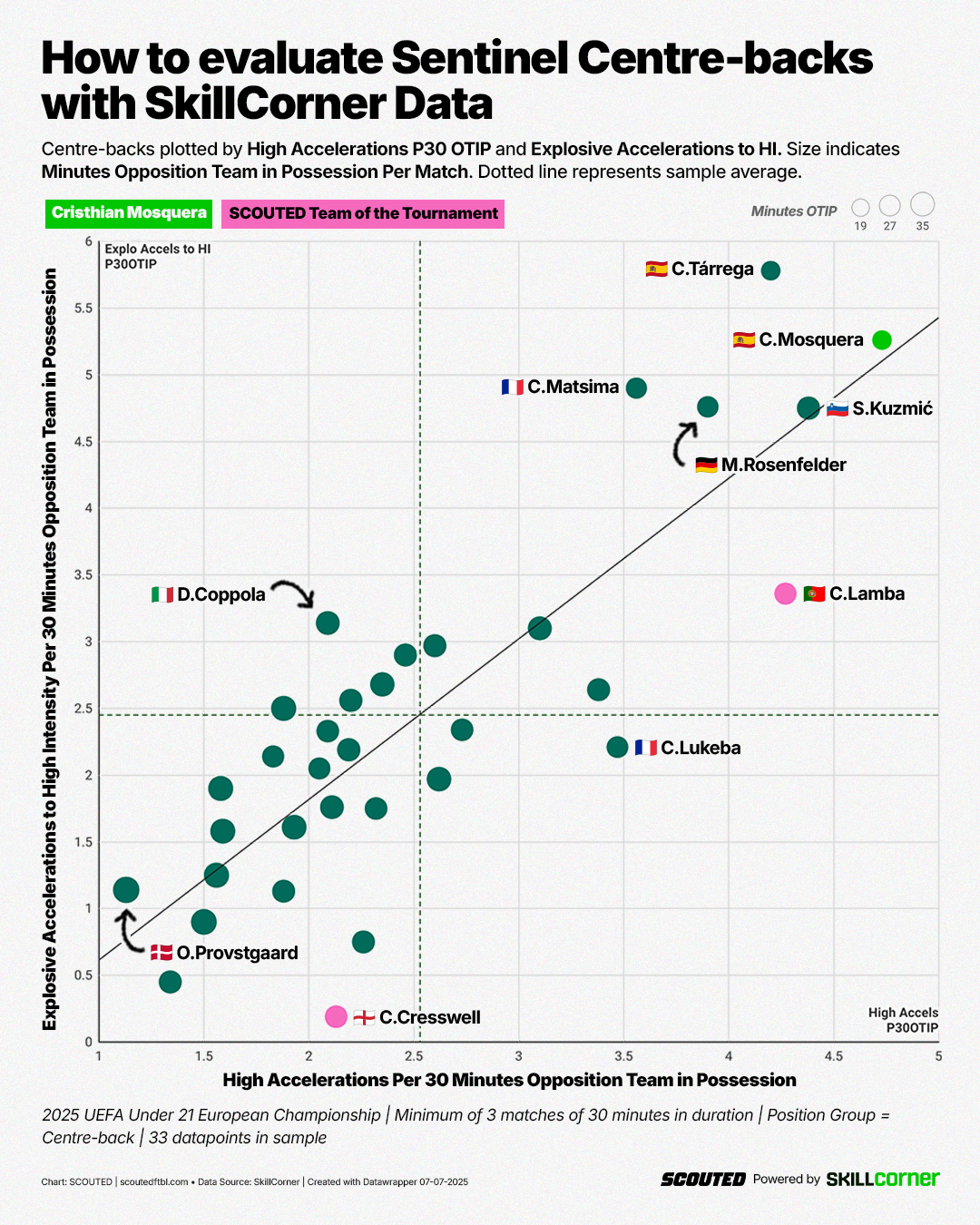
So how do we better evaluate players in this role? Well, what separates the Spanish duo from the French is that when they go, they go. We can illustrate this by looking at the Percentage of HSR and Sprints recorded via Explosive Accelerations.
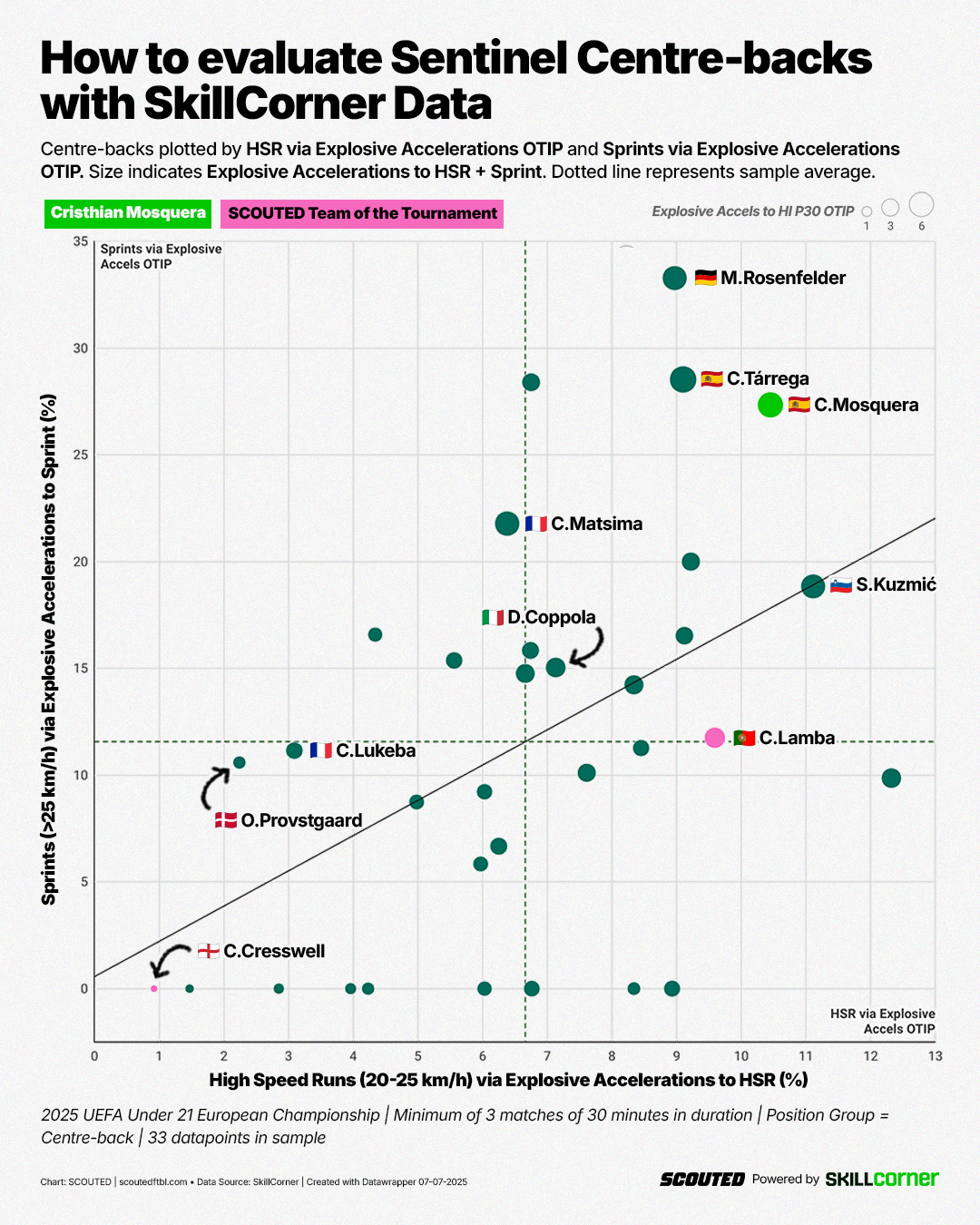
Mosquera himself is the only player that ranks in the top five for both HSR via Explosive Accelerations and Sprints via Explosive Accelerations. So, not only does he frequently engage his thrusters, but he consistently reaches the target speed band from a standing start. I would argue this is what “deceptive speed” and “mobility to cover big spaces behind defence” looks like.
To address the elephant in the room, SCOUTED Golden Ball winner Charlie Cresswell does not appear to share this trait. We know his output could be informed by England’s approach, but his semi-permanent position in the bottom left of all the data visualisations confirms that Cresswell really is a Mountain. And a Mountain cannot be moved.
While it seems Cresswell would not excel in a team that leaves a lot of space in behind, Mosquera appears to be built for it. But exploring the Spaniard’s profile has also highlighted just how important it is to consider a team’s tactical set-up when recruiting a particular Archetype.
Full-back: Marc Pubill
The Flyer Full-Back is blasting off again and while I expect Tino Livramento to sit at the top of the following tests for this Archetype, I also expect to see a Spaniard.
Marc Pubill was an unknown quantity to me pre-tournament but within the first 15 minutes of Spain’s opening game, it was the Almería right-back’s willingness to overlap and underlap that immediately caught the eye. The data backs us up.
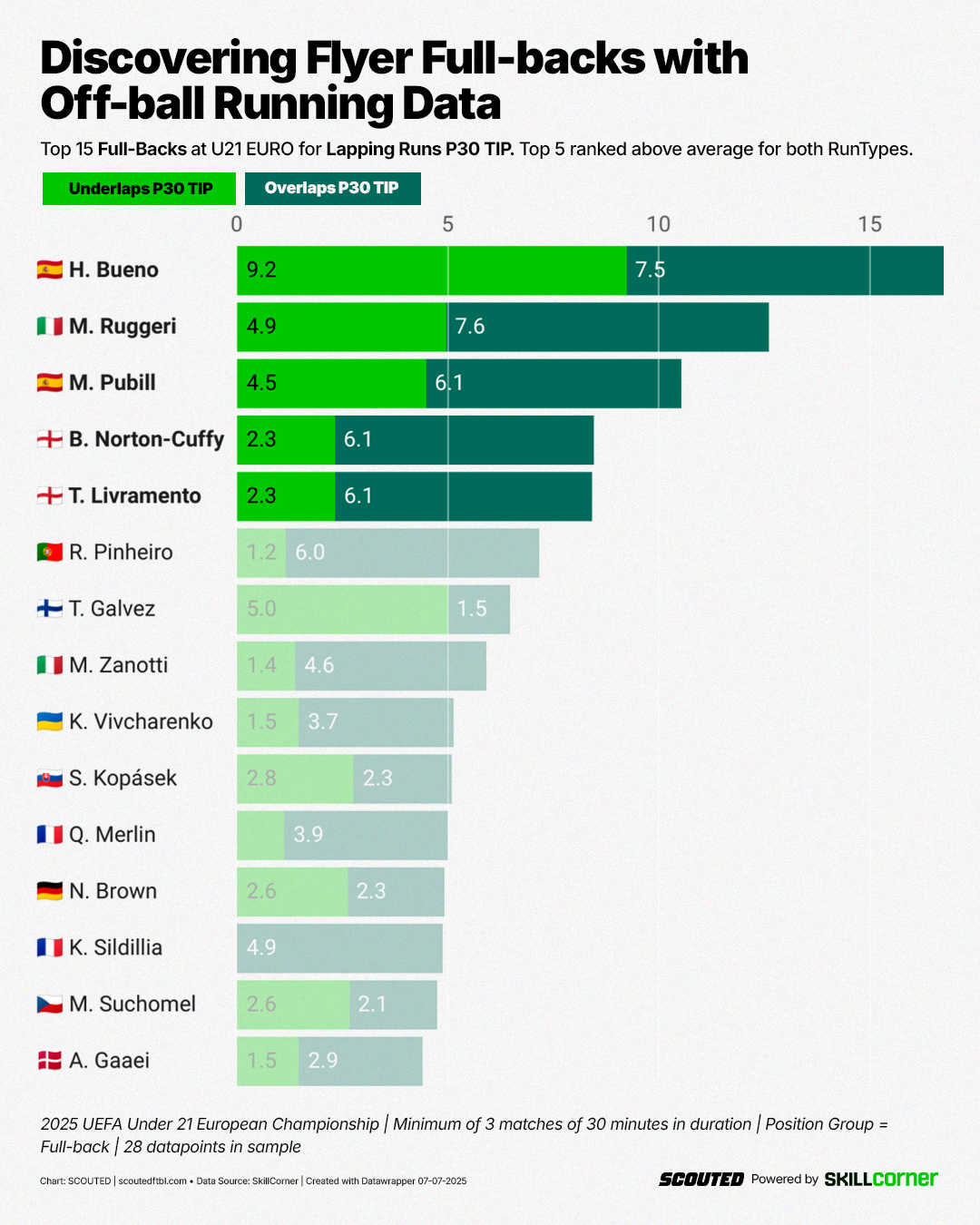
Pubill was one of five Full-backs that ranked above average for both Overlaps and Underlaps P30 TIP during the tournament. That’s a tick for substance. The fact he ranks second for the Percentage of Off-Ball Runs made as Lapping Runs is a tick for style, too.

Another benefit of cross-referencing data with match notes is that you will also flag players you might have missed. As a lesser-known quantity, my focus was analysing Pubill during Spain’s matches. In doing so, Bueno’s addiction to Lapping Runs passed me by.
But pouring over Pubill’s profile introduced a key step when evaluating Passing profiles. In general, we expect a Flyer Full-back to make plenty of Pass Attempts to Cross Receiver Runs. For Pubill, this was not necessarily the case. For Bueno, it certainly wasn’t.
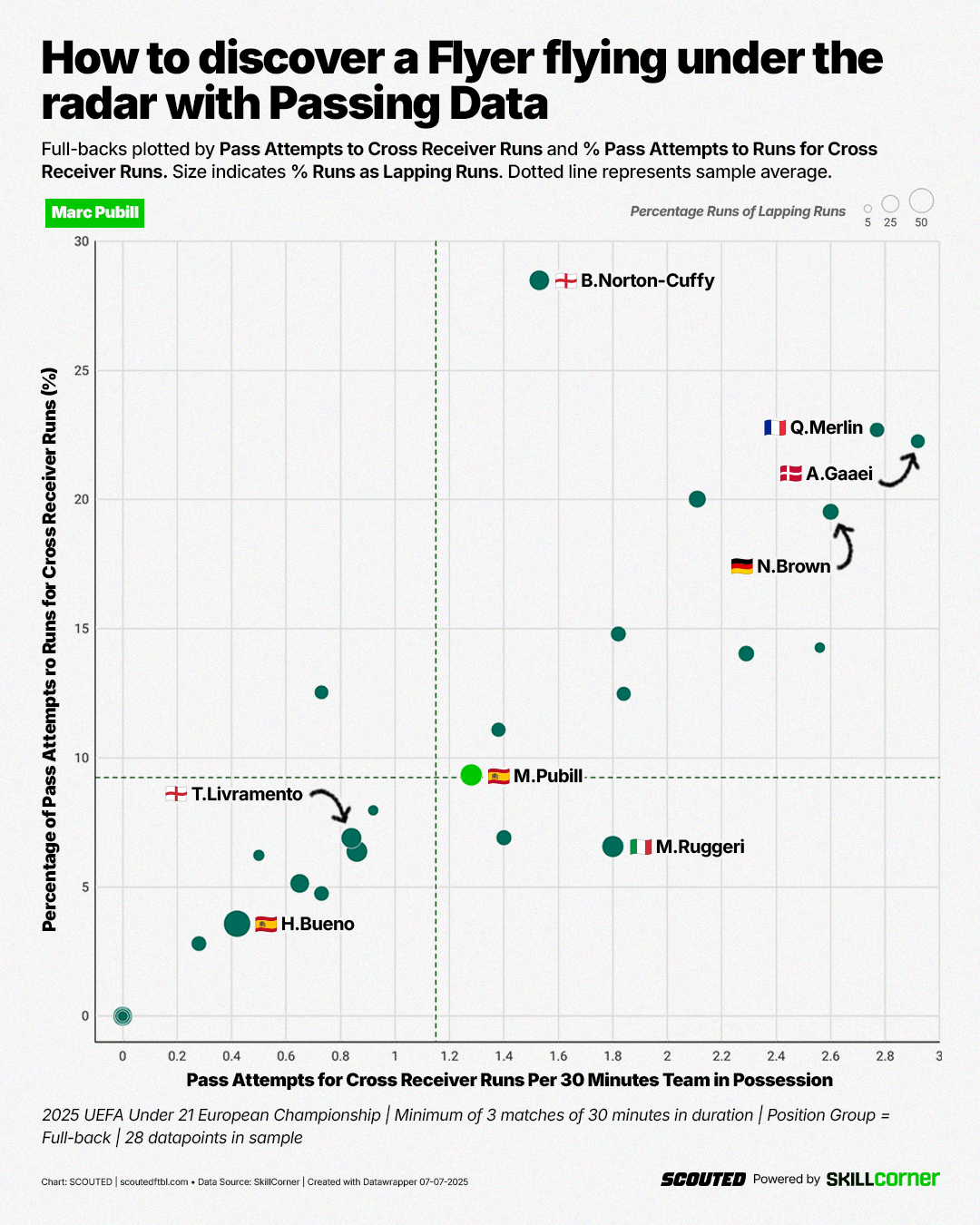
Pubill ranked above average for both metrics, but the likes of Quentin Merlin blew him out of the water. The only member of our Lapping outliers that had the Passing profile to match was Brooke Norton-Cuffy - and that may have been influenced by his minutes at right midfield. But remember: you cannot make a Pass to a Run if the Run is never made in the first place.
Therefore, visualising the willingness of a Full-back to target Cross Receiver Runs becomes a key step. Despite Pubill ranking below average for Opportunities to Pass to Cross Receiver Runs, he ranks third for actively targeting them, attempting to pass to 80.5%. Bueno, meanwhile, was much more reluctant.
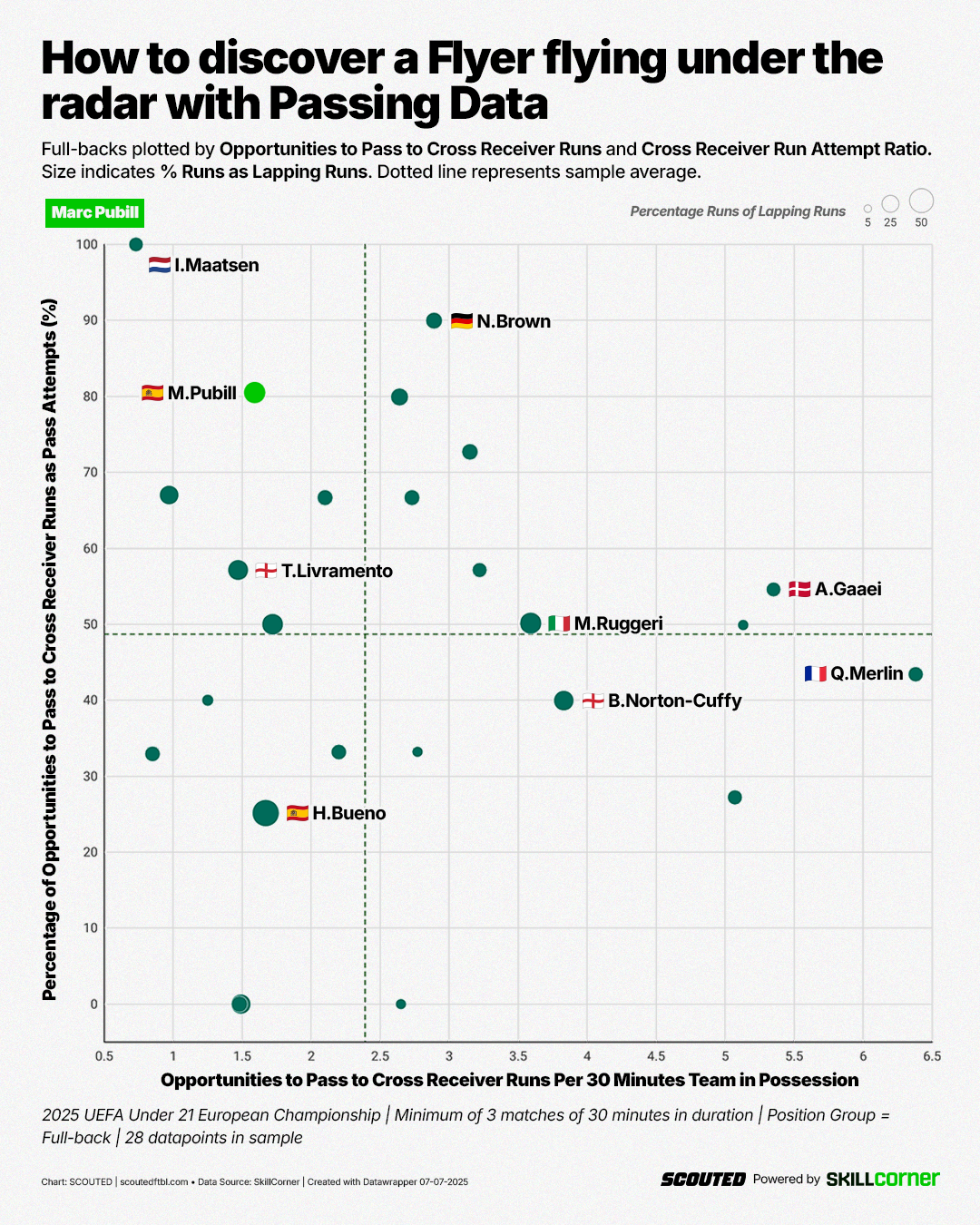
This is the symbiosis of traditional and data scouting in action. Watching Pubill has taught us more about how to evaluate a Flyer based on team context. Judging them on the volume of their Pass Attempts to Cross Receiver Runs should still be part of the process, but it must be in conjunction with an assessment of their proclivity to do so. The purest of Full-back Flyers harmonise substance and style. That is only achieved when their perfect nest has been built.
Midfielder: Diogo Nascimento
We spotlighted Diogo Nascimento throughout the tournament because of his mastery of the Vitinha role. In SCOUTED Archetype parlance, he is a Platformer. His task is to set up the rest of his team for success by creating angles to receive from the centre-backs and firing forward passes to teammates ahead of him.
Overcoming Pressure is a valuable suite of Data to identify the Platformer, but its use slowly blurs the lines between the Platformer and another Archetype. Enter Noah Nartey.
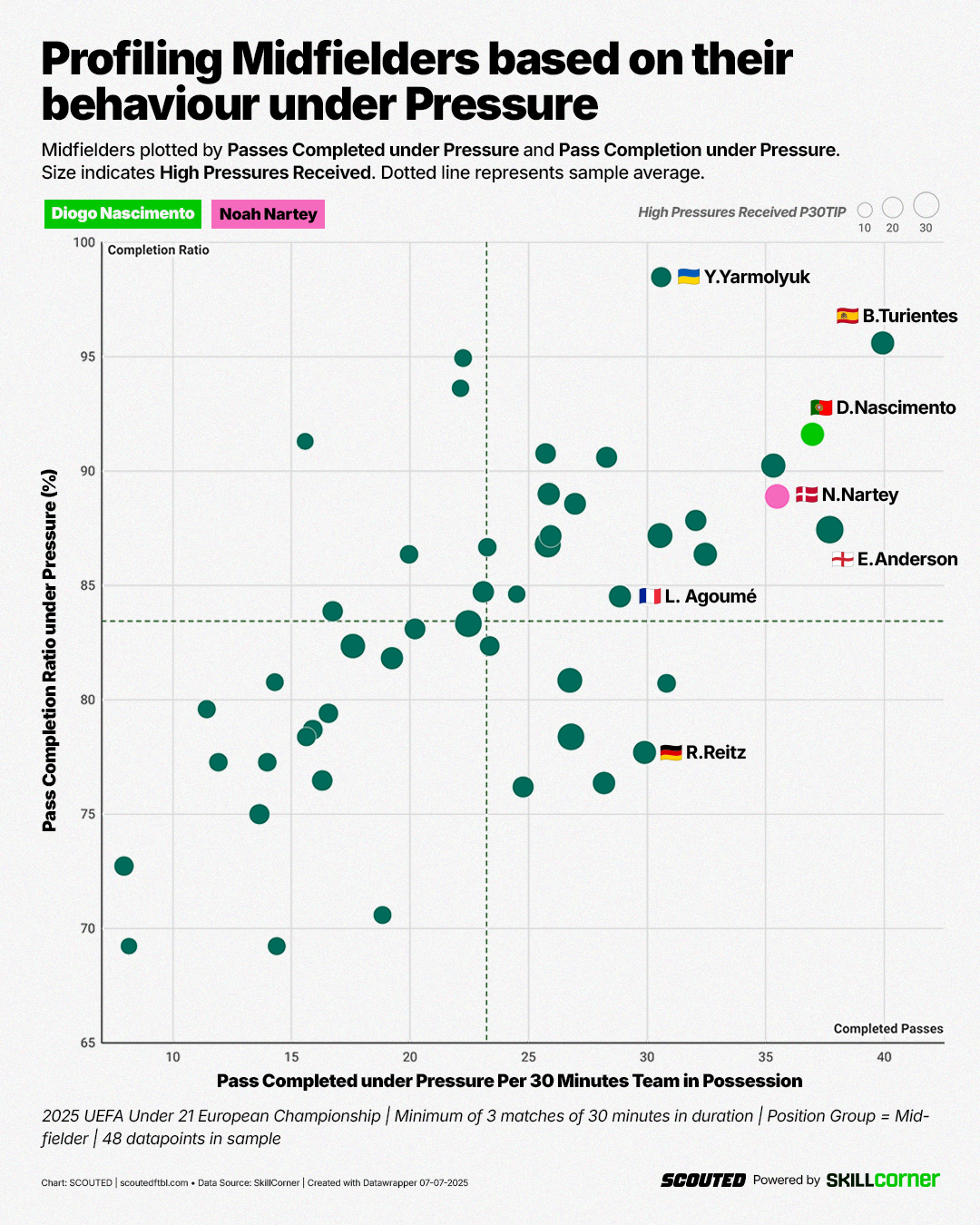
Llew recently pinned the Danish midfielder as the Poster Boy for our newest Midfield Archetype: the Defuser. As described, a Defuser “constantly flips perilous situations into advantageous ones for his teams. He turns pressure into positives.”
So how do we separate a Platformer from a Defuser? Exploring their Passing and Off-ball Running profiles illustrates clear distinctions. As we continue, bear this in mind from Llew’s Nartey analysis:
“Instead of bouncing the ball back to the centre-back or perhaps spinning it out to the full-back, Nartey takes it upon himself to add some impetus to Denmark’s build up. His turn-and-burst took a couple of defenders out of the game and created a situation where he could slip in a team-mate to drive directly at the Ukrainian defence.”
Here are the Passing Tendencies of Nascimento and Nartey from the U-21 EURO.
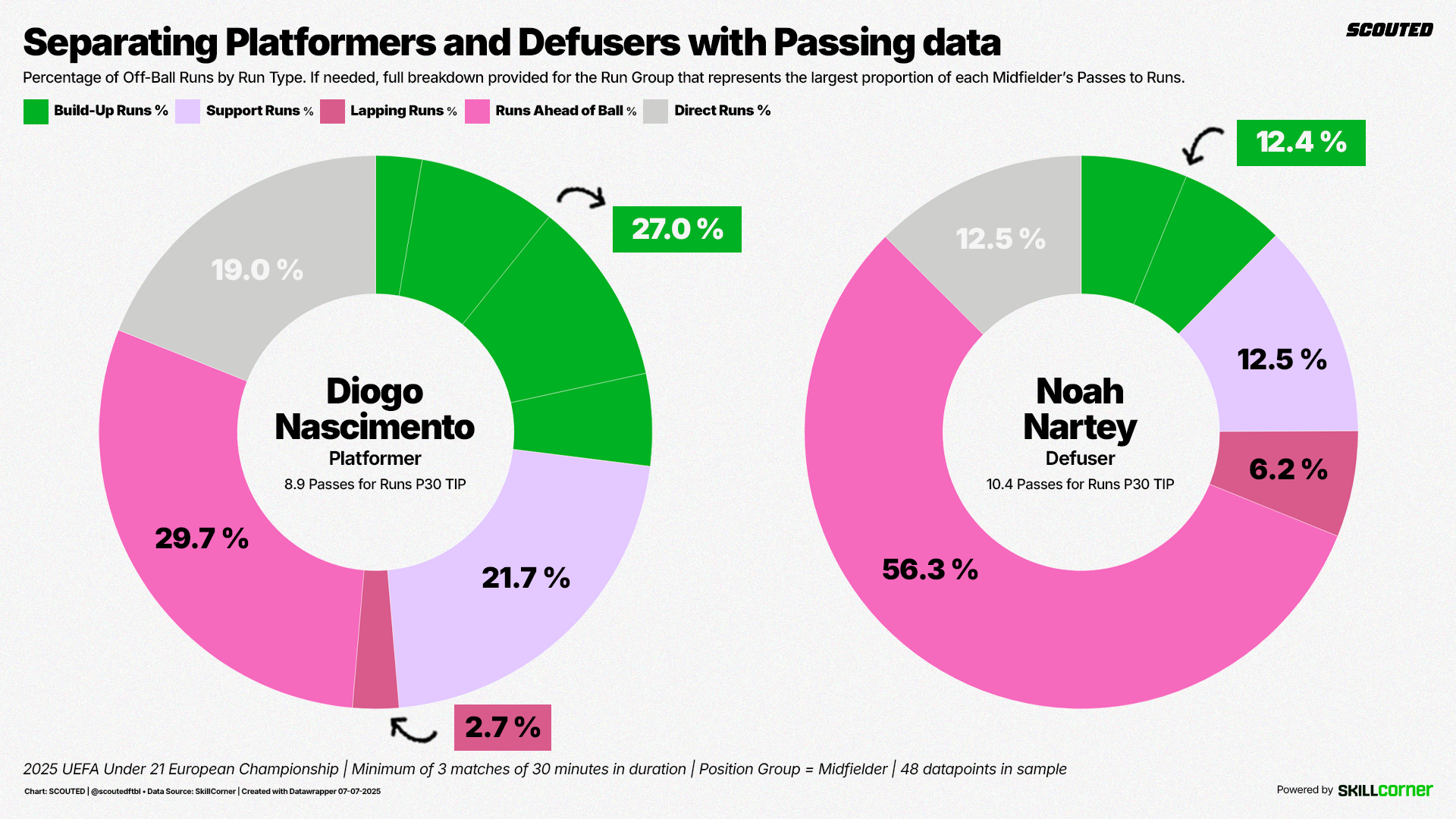
Llew’s observation appears in the data: The majority of Nartey’s Pass Attempts to Runs are Pass Attempts to Runs Ahead of the Ball. The average for a Midfielder is 34.6%. Runs Ahead of the Ball add verticality as they are made towards the opposition goal but do not break the last line of defence. That is the impetus.
Now, Nascimento still attempts an above average number of Passes to Runs Ahead of the Ball, but these represent just 29.7% of his Attempts; only slightly more than the 27% made up by Attempts to Build-Up Runs. In complete contrast, Passes to Build-Up Runs make up just 12.4% of Nartey’s passing portfolio. A similar pattern, although less extreme, emerges when looking at the Off-Ball Running profiles.
Build-Up Runs
Essentially, any run in which the recipient is asking for the ball to feet.
- Dropping Off: a run towards the team in possession’s goal to open a passing angle
- Coming Short: a run towards the player in possession to receive a short pass
- Pulling Wide: a run starting in the centre of half-space channel and ending in the wide channel with the location wider than the player in possession
- Pulling Half Space: a run occurring in the attacking third that starts in the centre channel and ends in the half space channel
Progression Runs
Within this group, there is an important sub-group for the Flyer Archetype in particular.
- Support Runs: a run originating behind the player in possession trying to engage in offensive play
- Overlap: a run in the wide or half-space channels, originating behind the player in possession and ending ahead and outside of the player in possession
- Underlap: a run in the wide or half-space channels, originating behind the player in possession and ending ahead and inside of the player in possession
- Runs Ahead of the Ball: a run originating ahead of the player in possession, running towards the opponents’ goal but not going beyond the last defensive line
Combine Overlap and Underlap to create Lapping Runs.
Direct Runs
These runs are typically closest in proximity to the opposition box.
- Runs In Behind: a run into space behind the opponents’ last defensive line
- Cross Receiver Runs: a run towards the penalty area to receive a possible cross
Despite both players sharing Coming Short and Support Runs as the primary and secondary Run Types, Nascimento is more likely to move laterally or retreat to secure possession with 54.2% of his Runs as Build-Up Runs. Meanwhile, Nartey has a propensity to move vertically to advance possession; 66.1% of his Runs are Progression Runs. Therein lies the difference.
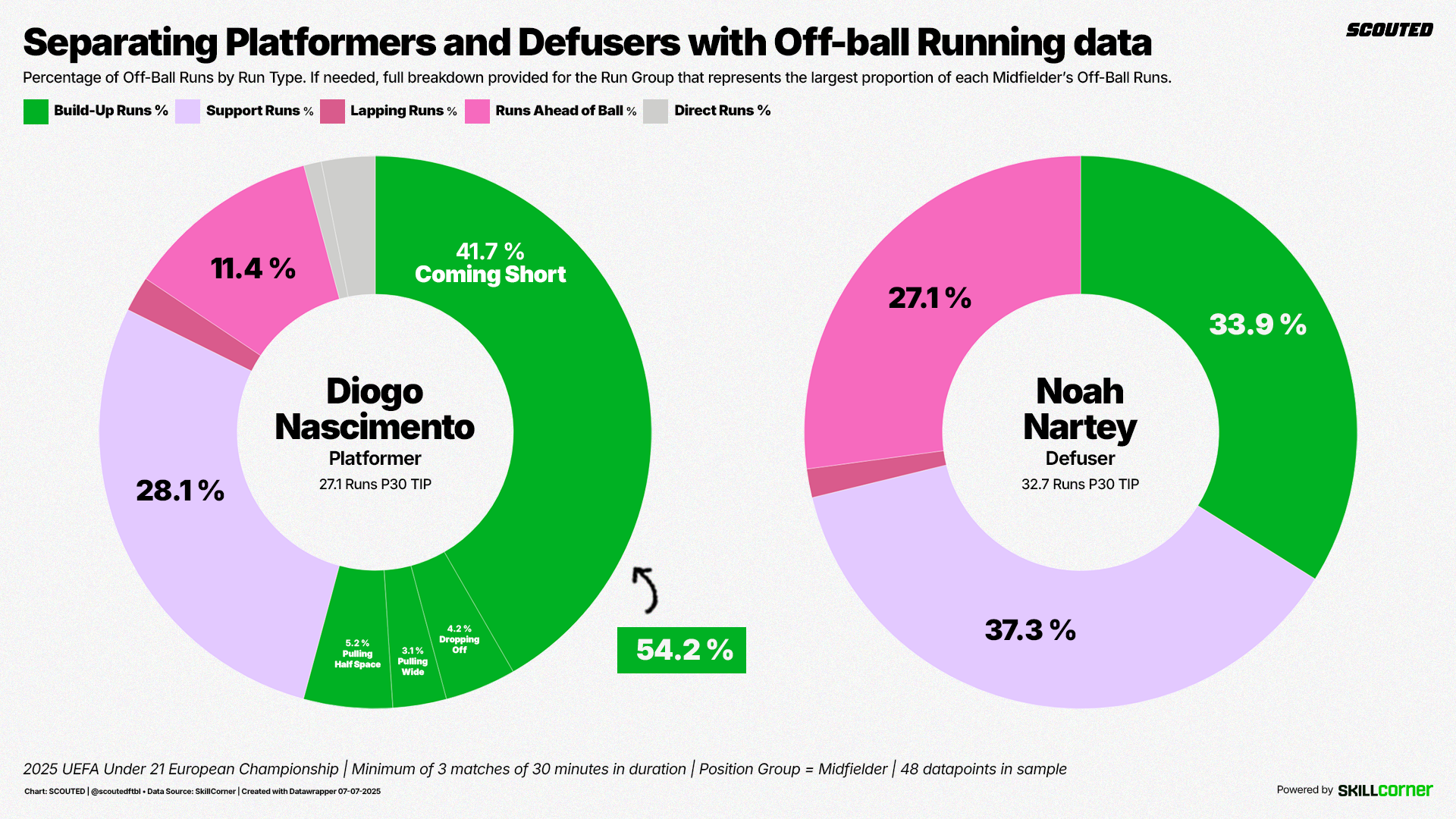
While both excel at Overcoming Pressure, a Platformer aims to retain possession following the evasion of pressure through Passes to lateral or even retreating Runs. A Defuser, who excels under the highest degree of pressure, aims to progress possession through the increased verticality of the actions that follow their escape from it.
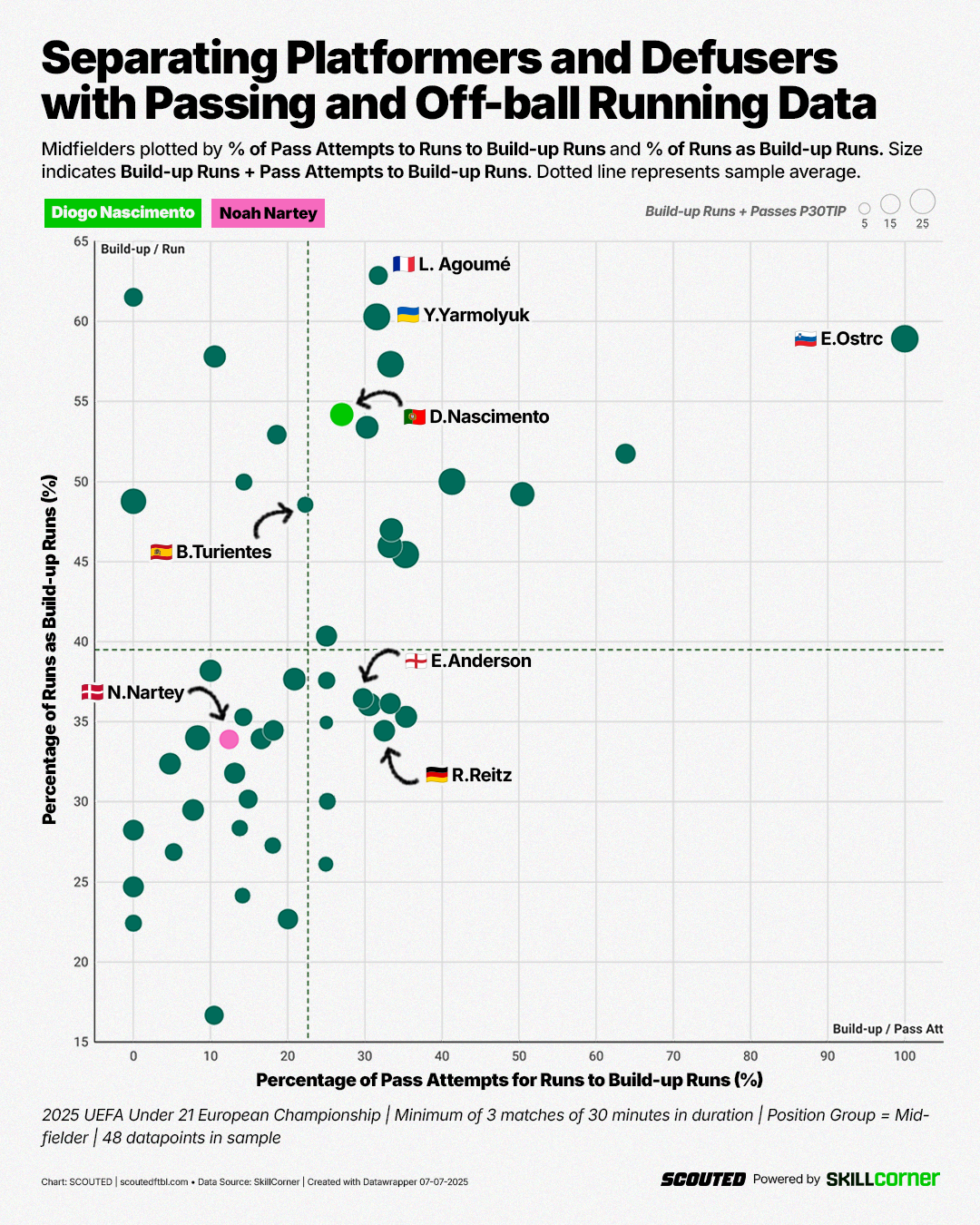
By watching and then analysing both Nascimento and Nartey at the U-21 EURO, we have a clearer understanding of what should separate these two Midfield Archetypes.
Wide Attacker: Clement Bischoff
Clement Bischoff was the youngest player in the Denmark squad but arguably the most impressive. During the Group Stage, I named him as one of the best players I had watched at the tournament.
The 2005-born winger was deployed at wing-back for Bröndby IF during the 2024/25 Superliga season but found himself in a more advanced role in Slovakia. On the ball, he was a cerebral playmaker operating from the left-wing, his smooth touches and effortless combination play a delight. But he also displayed the ability to ride pressure, carry the ball forward and win fouls when needed. He uses his body very well. Bischoff’s skillset reminded me of watching Jadon Sancho at UEFA Youth Tournaments in 2017. If you want a trending comparison, think Eberechi Eze.
In SkillCorner data, Bischoff stood out for Dangerous Passing; a true Safecracker. He ranked first for Opportunities, Attempts and Completed Passes to Dangerous Runs P30 TIP.
This was inflated by team environment, as we saw with Mosquera and Nascimento, but again it was Bischoff on top rather than other Danish teammates.
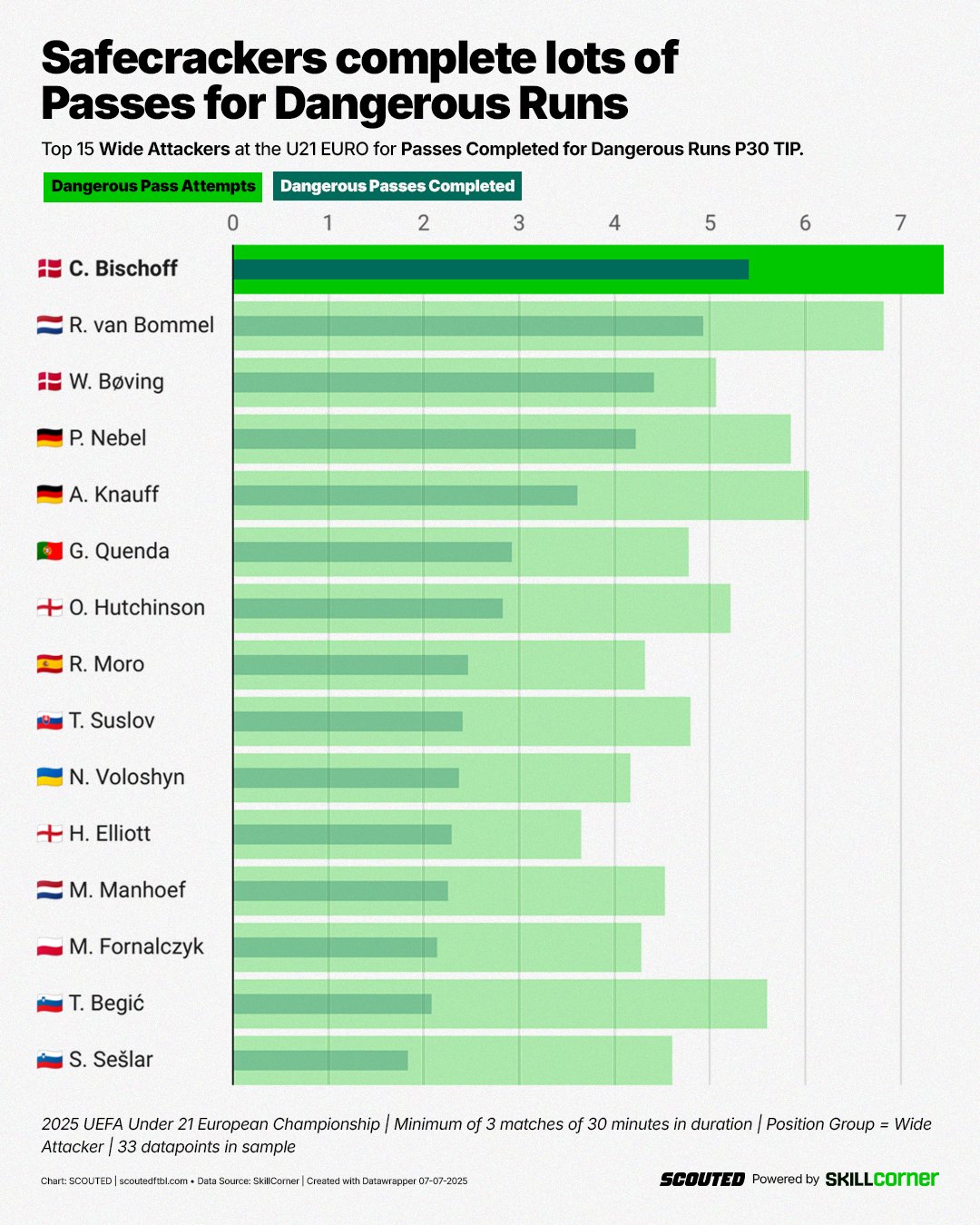
To cut through team noise, however, we can begin to quantify the unquantifiable skill of vision through the Percentage of Pass Attempts to Runs that are Pass Attempts to Dangerous Runs.
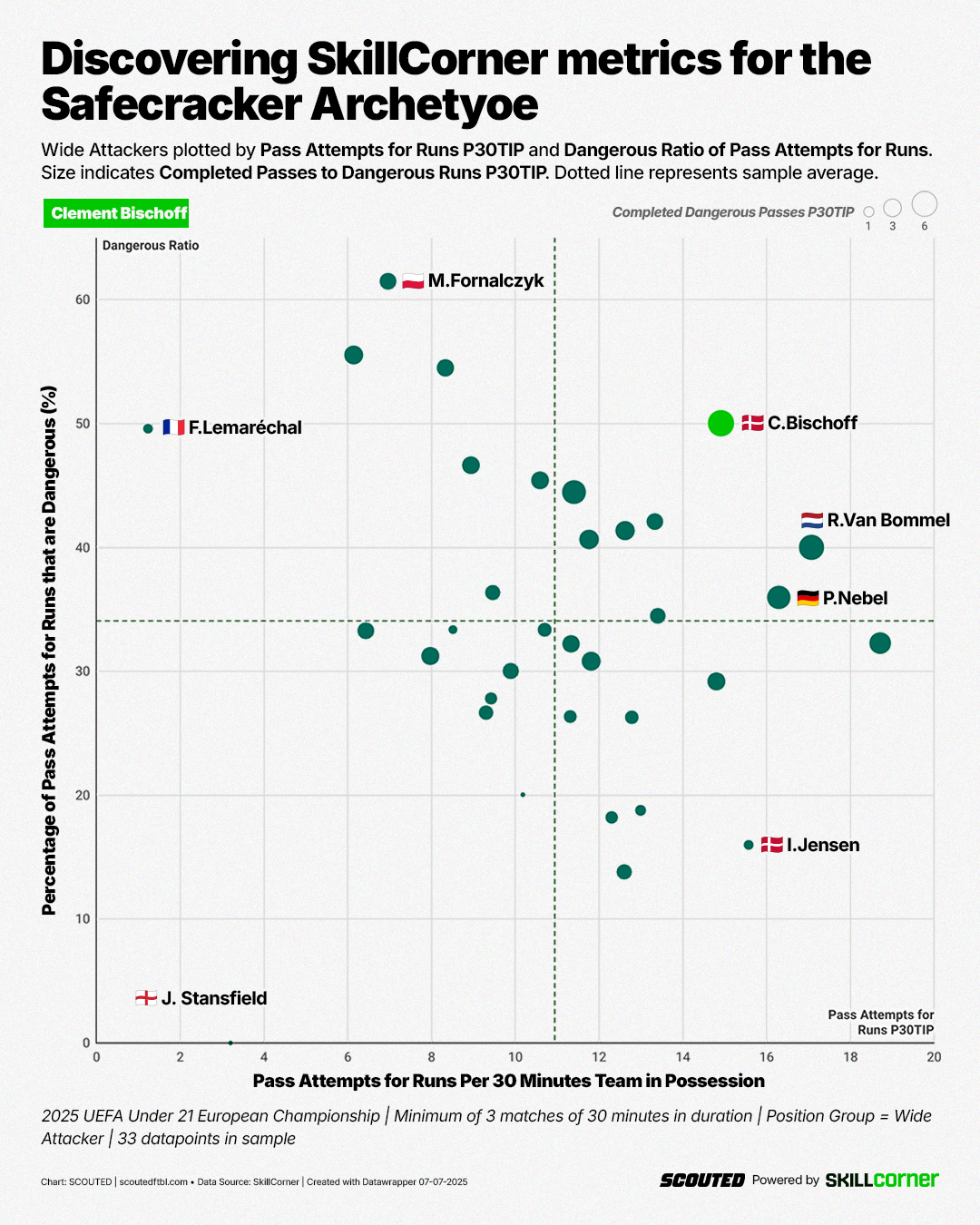
In general, the more Attempts, the lower the Dangerous Ratio. Bischoff, however, defies that. Furthermore, if we look at Dangerous Passes through the prism of Overcoming Pressure, Bischoff teaches us even more about this Archetype. He ranks first for Dangerous Passes completed under High Pressure P30 TIP.
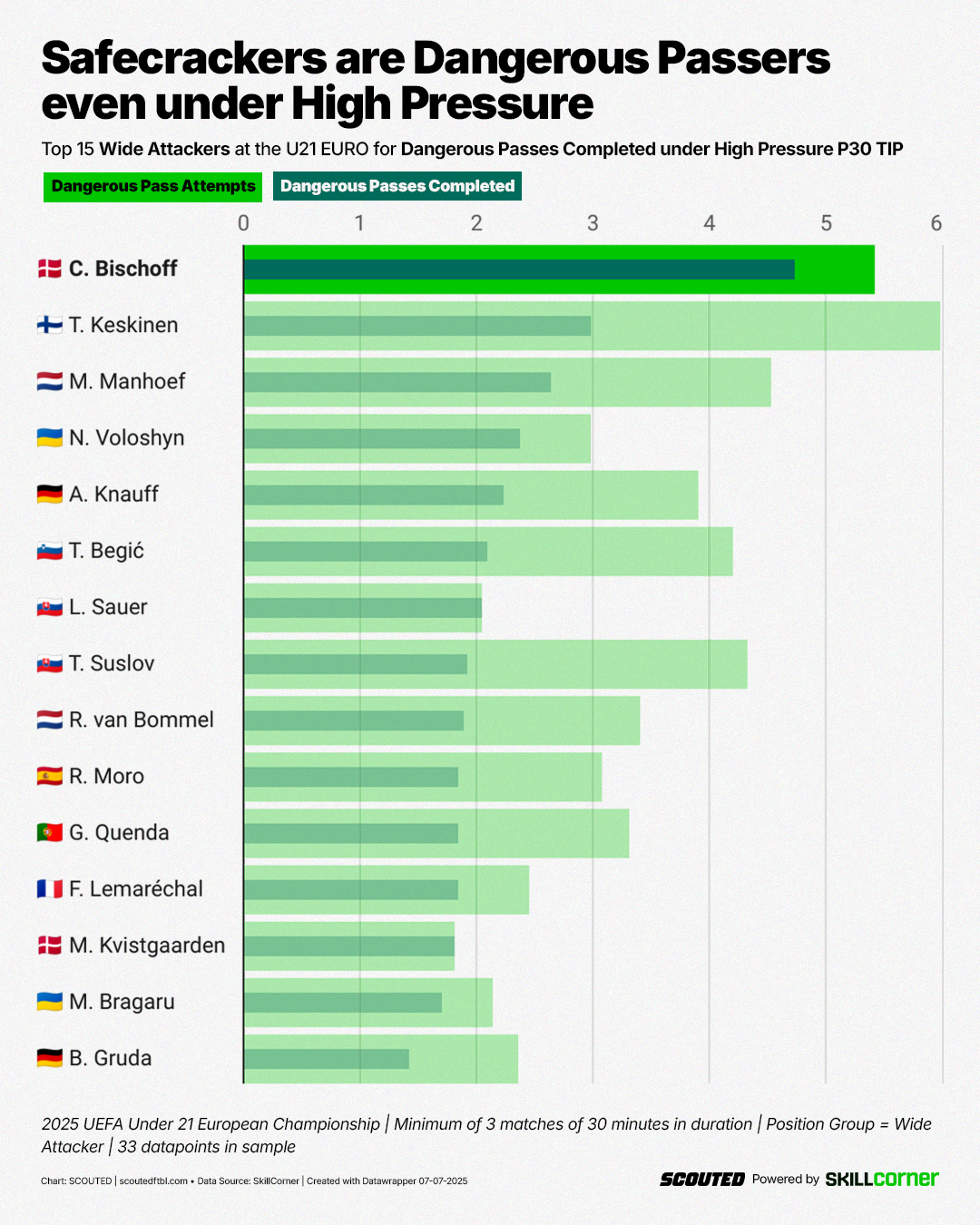
Even if you normalise this metric Per Match, Bischoff ranks first. His ability to spot and serve Dangerous Runs is one thing - maintaining that level while under the most intense pressure is next level. Combining this with the ability to execute the most Difficult Passes is how we will judge Safecrackers when we return to the Archetype in the future.
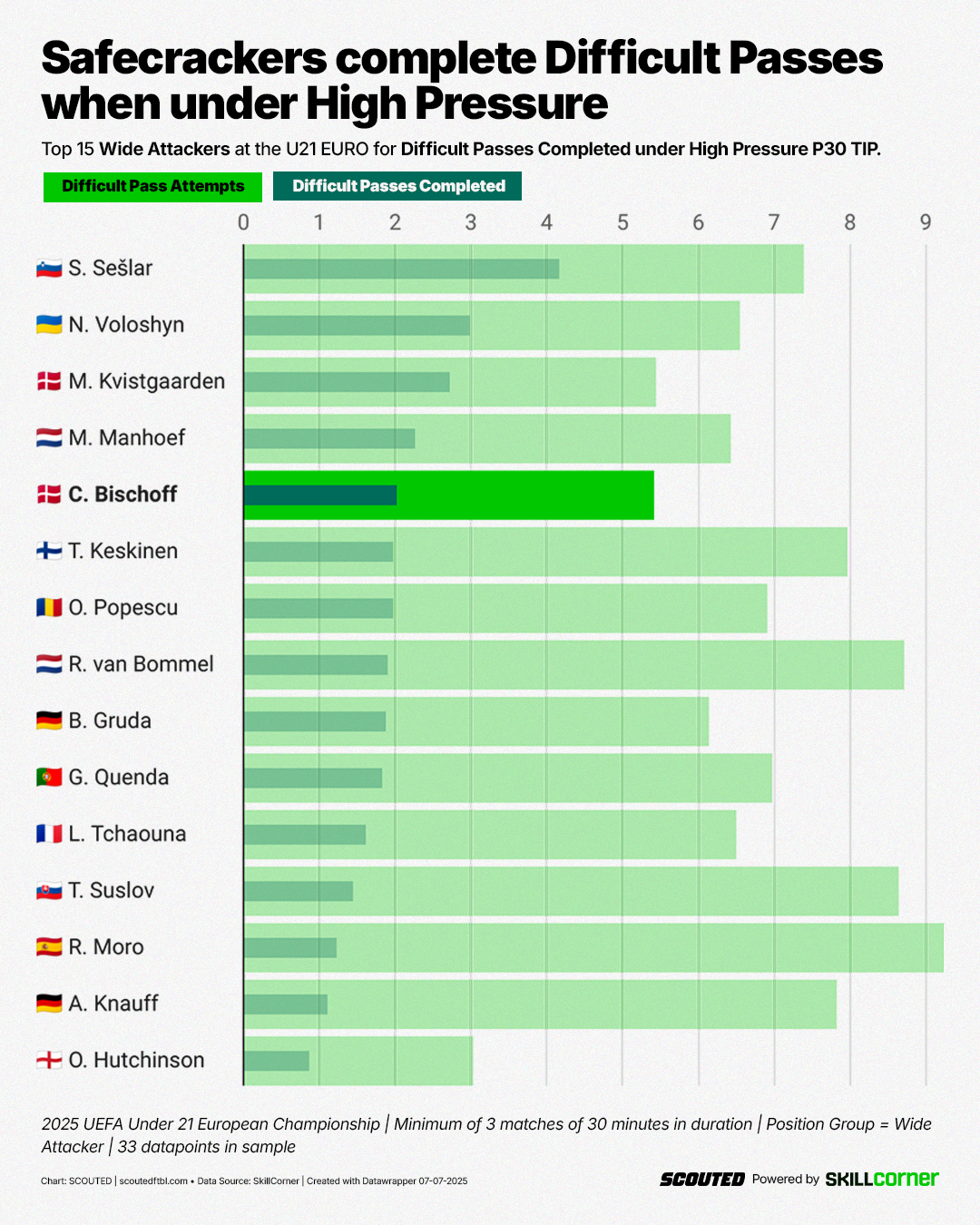
Centre-forward: Nick Woltemade
Nick Woltemade was undoubtedly the standout Centre Forward at the tournament. He scored the most goals and even provided the most assists. But he has always been difficult to define as a player: he dribbles often but he does not run hard; he’s massive but does not continuously throw himself at crosses - the source of his domination is elusive. Watching him closely at this tournament, however, has led me to a discovery.
Not a match went by without Woltemade wrapping his arms around an onrushing centre-back or, at the very least, grabbing a handful of their shirt. As a result, he is a big outlier when it comes to Ball Retention under Pressure. Is this the pinning metric?
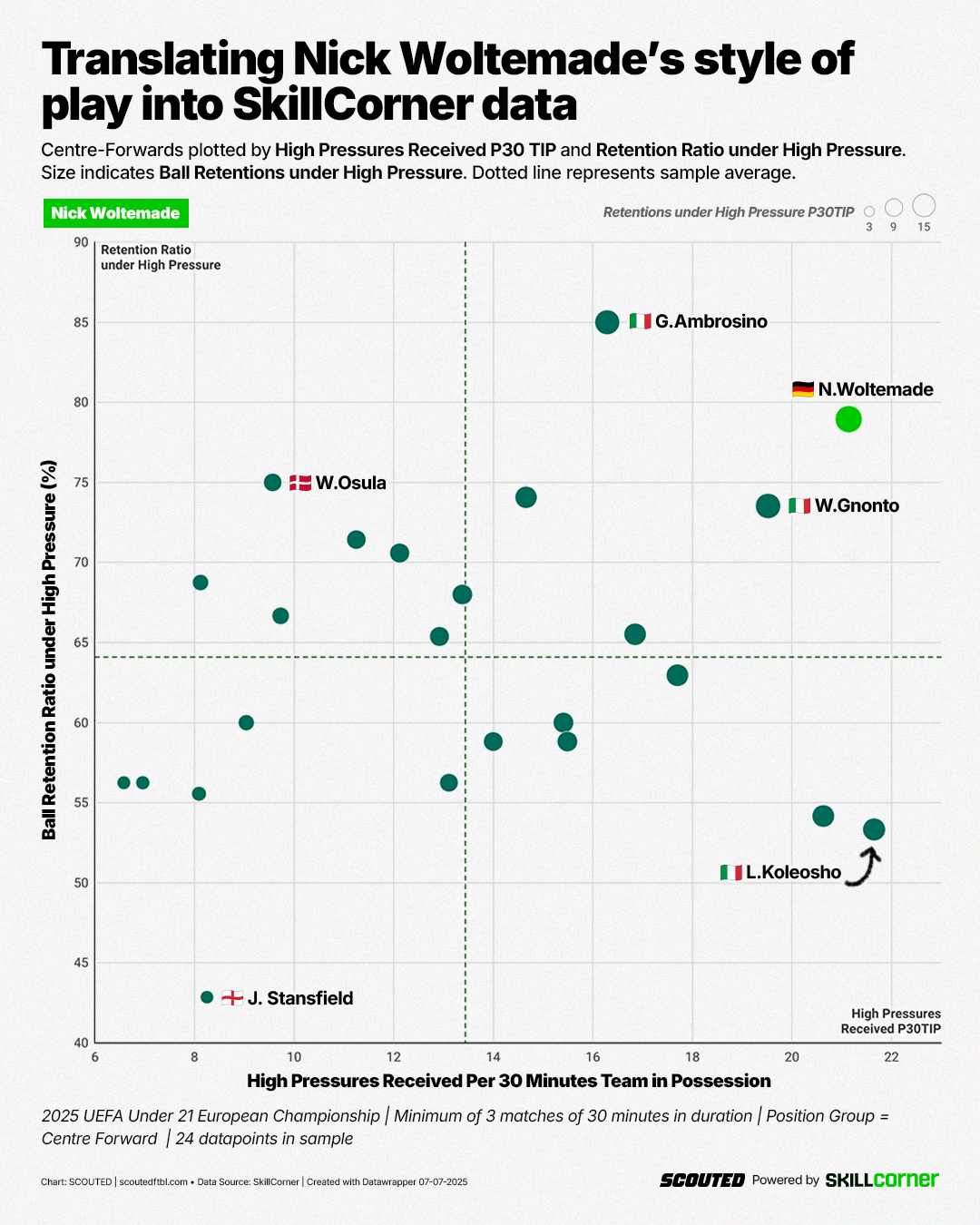
Woltemade ranked first for Ball Retentions under Pressure, under Medium Pressure, and under High Pressure. He ranked first for Retention Ratio under Pressure and second for Retention Ratio under High Pressure. He is a sponge. You could argue it’s a translation of these images into data:
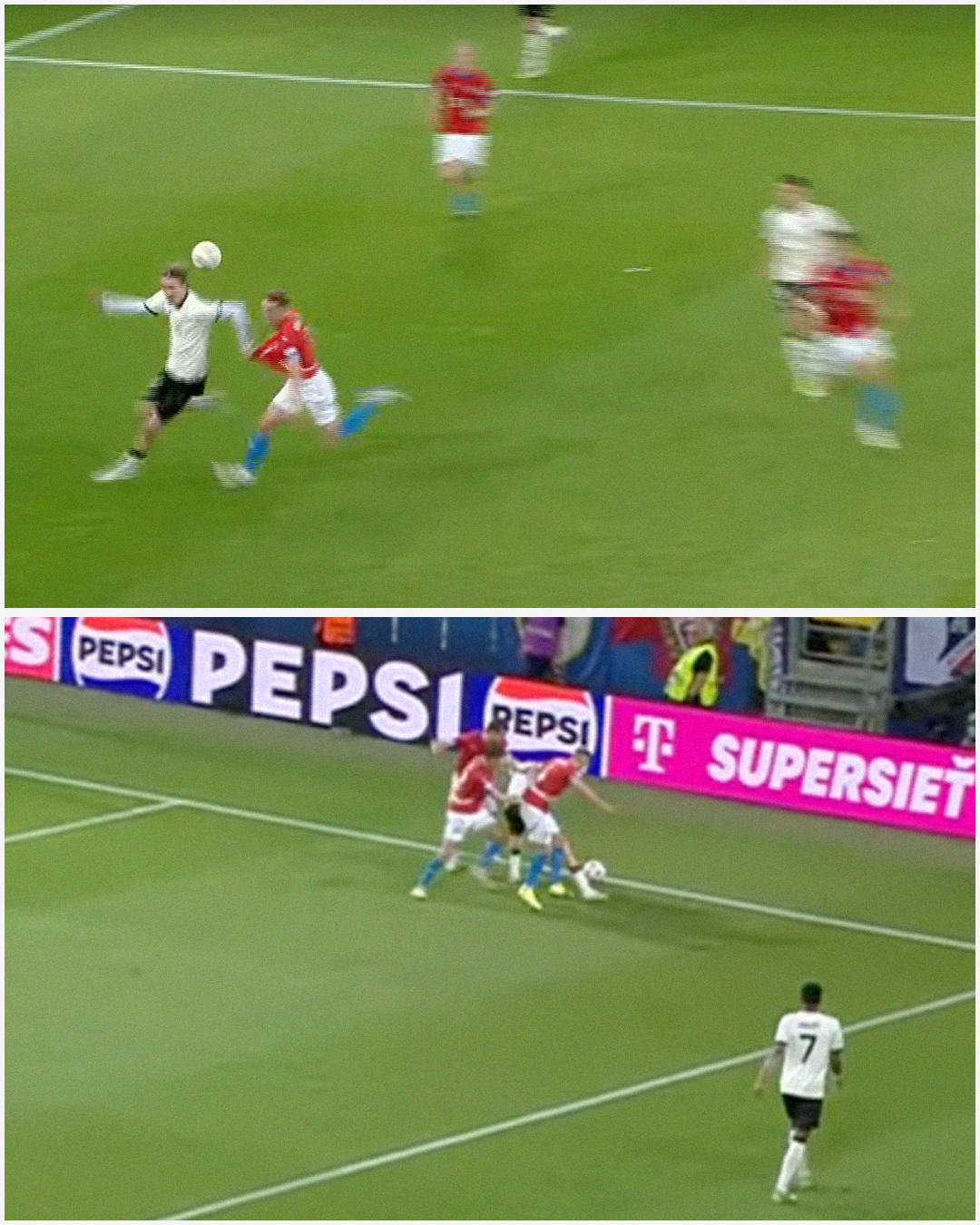
Of our notes on Woltemade, one line stood out: we said the forward was in a “perpetual state of sauntering”. After wrestling centre-backs, completing a dribble and offloading the ball, Woltemade drifts forward, rather than spinning in behind. The next scatter, focussing on Off-Ball Running, provides an extreme contrast to the first.
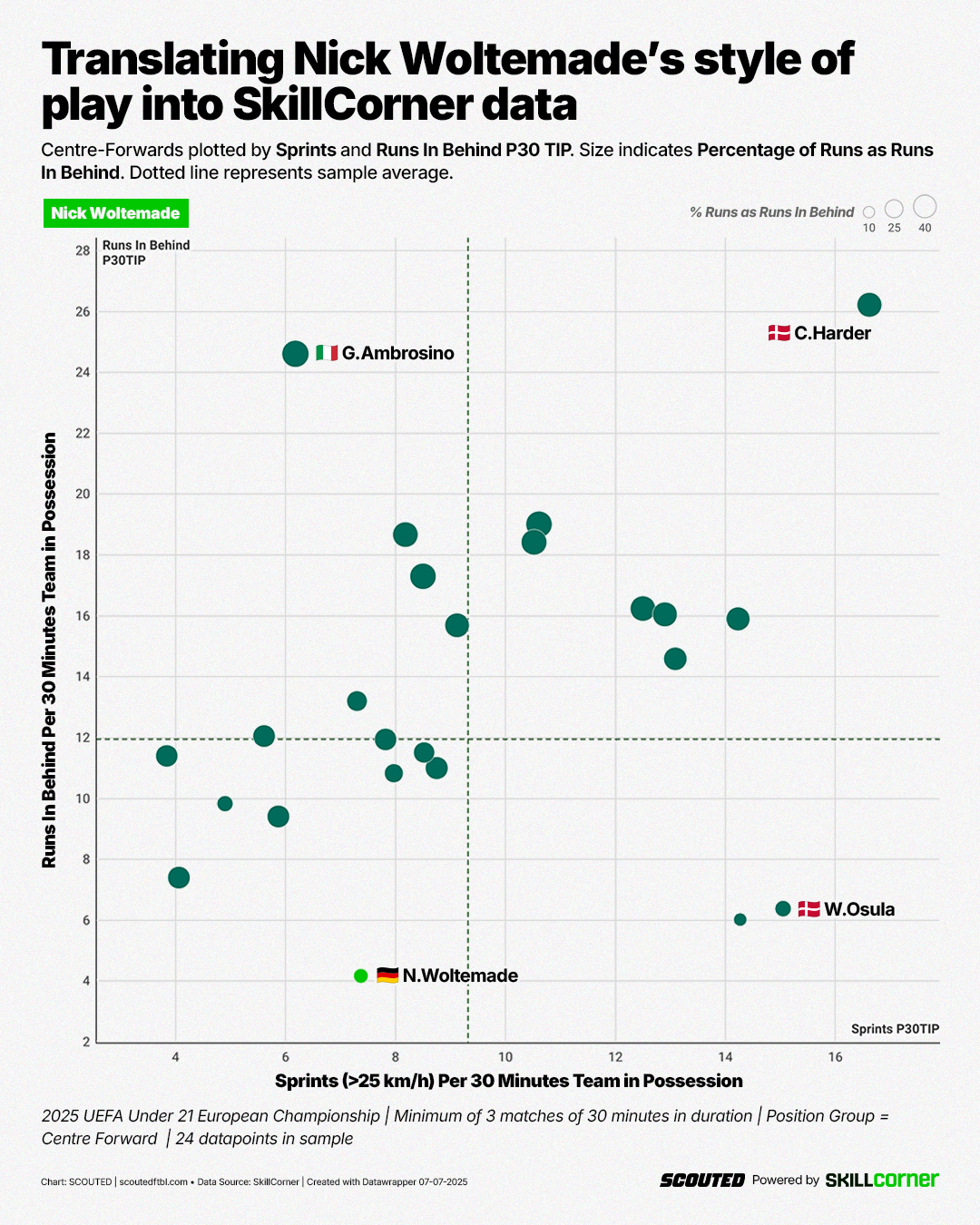
Conrad Harder is a relentless off-ball runner and Runs In Behind are his calling card: a Power Forward in the mould of Viktor Gyökeres. Woltemade is the complete opposite. Instead, he is an outlier for two Run types: Coming Short and Support Runs.
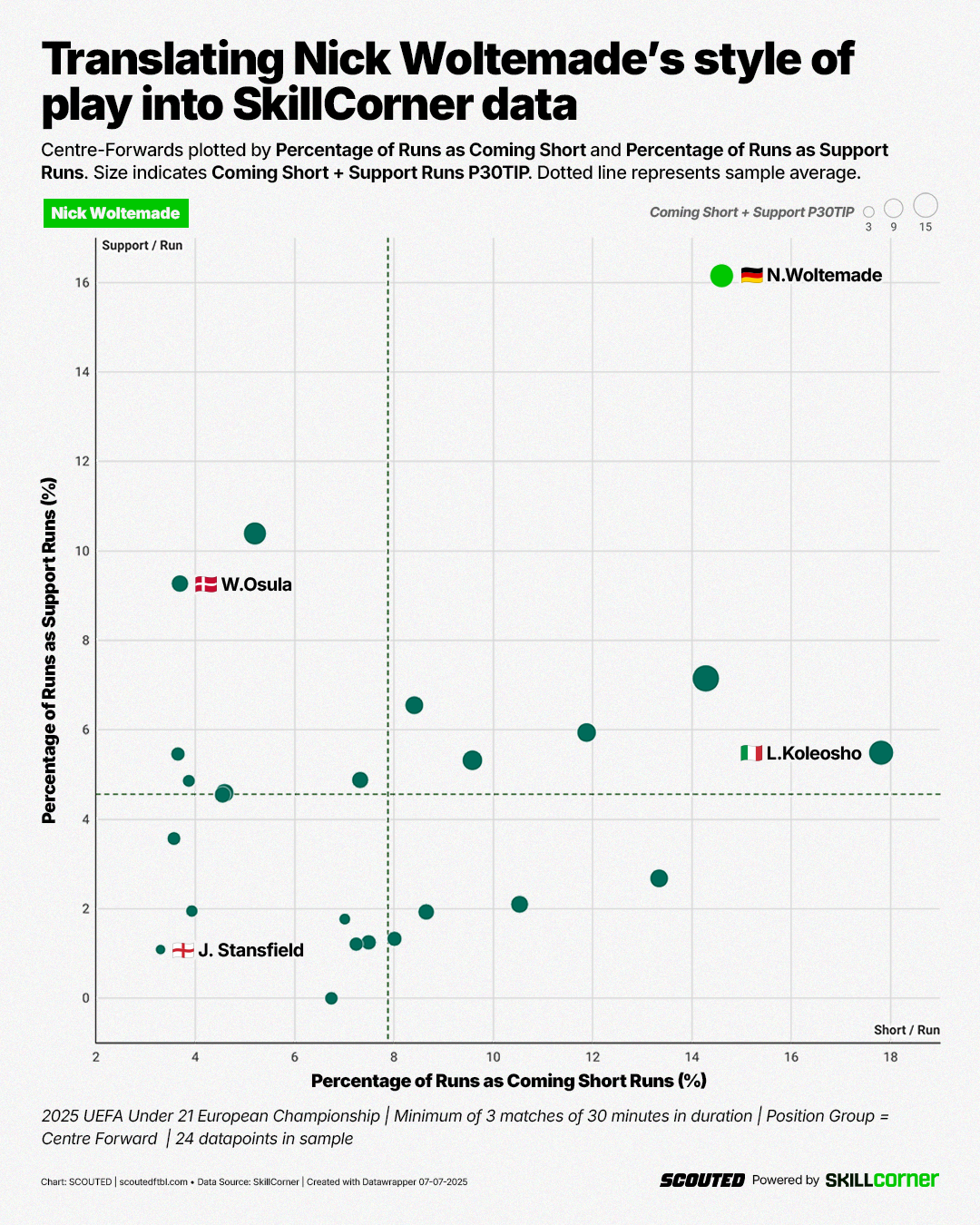
These two Runs make up 30% of his Off-Ball Running profile. The average is 12.5%. His penchant for Support Runs in particular captures the German’s nonchalant approach to running towards goal. Remember, these Runs originate behind the player in possession.
This is further illustrated by his below average output and preference for Cross Receiver Runs combined with a lack of Explosive Accelerations. Sauntering.
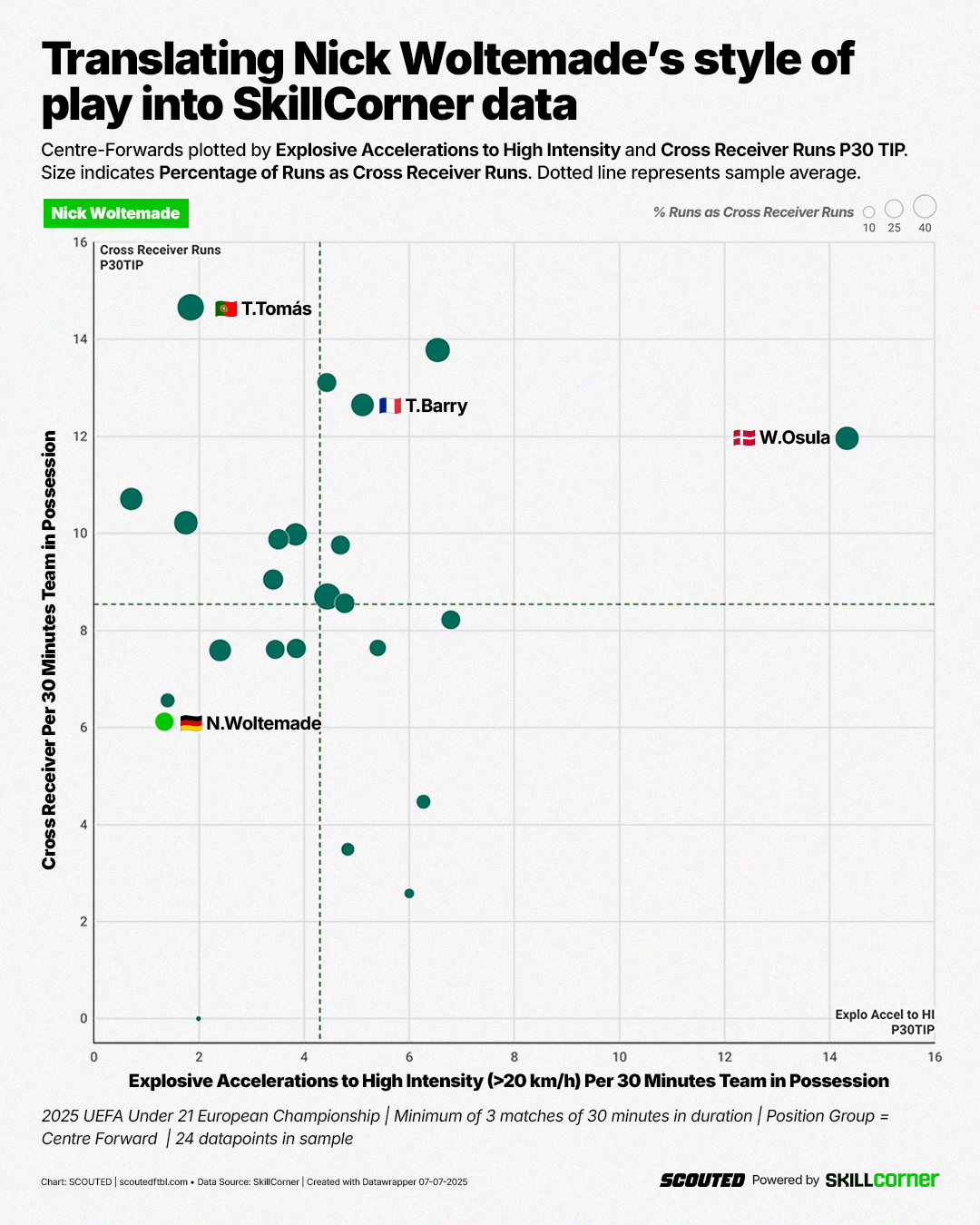
Through watching Woltemade closely, we have discovered a potential chain of metrics - Coming Short, Overcoming Pressure then Supporting - from which we can develop and evaluate a new Centre Forward Archetype, one which deviates from what might be expected of a player of his size.
This is a perfect précis of what we hoped to accomplish with this exercise: the eye test and data scouting in perfect harmony. Now we can take our learnings forward.
This newsletter was produced under a commercial collaboration with SkillCorner, SCOUTED’s official data partners. Their tracking and performance data is used by more than 150 of the world’s biggest clubs, leagues and confederations.



